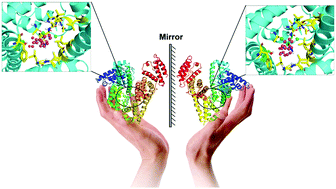Enantioselective recognition of an isomeric ligand by a biomolecule: mechanistic insights into static and dynamic enantiomeric behavior and structural flexibility†
Abstract
Chirality is a ubiquitous basic attribute of nature, which inseparably relates to the life activity of living organisms. However, enantiomeric differences have still failed to arouse enough attention during the biological evaluation and practical application of chiral substances, and this poses a large threat to human health. In the current study, we explore the enantioselective biorecognition of a chiral compound by an asymmetric biomolecule, and then decipher the molecular basis of such a biological phenomenon on the static and, in particular, the dynamic scale. In light of the wet experiments, in silico docking results revealed that the orientation of the latter part of the optical isomer structures in the recognition domain can be greatly affected by the chiral carbon center in a model ligand molecule, and this event may induce large disparities between the static chiral bioreaction modes and noncovalent interactions (especially hydrogen bonding). Dynamic stereoselective biorecognition assays indicated that the conformational stability of the protein–(S)-diclofop system is clearly greater than the protein–(R)-diclofop adduct; and moreover, the conformational alterations of the diclofop enantiomers in the dynamic process will directly influence the conformational flexibility of the key residues found in the biorecognition region. These points enable the changing trends of biopolymer structural flexibility and free energy to exhibit significant distinctions when proteins sterically recognize the (R)-/(S)-stereoisomers. The outcomes of the energy decomposition further showed that the van der Waals’ energy has roughly the same contribution to the chiral recognition biosystems, whereas the contribution of electrostatic energy to the protein–(R)-diclofop complex is notably smaller than to the protein–(S)-diclofop bioconjugate. This proves that differences in the noncovalent bonds would have a serious impact on the stereoselective biorecognition between a biomacromolecule and chiral ligand. The present scenario is expected to attract more interest from both researchers and administrative agencies, since in a chiral environment, enantioselectivity exists in all of the biochemical processes of a chiral chemical, and this might finally elicit the disparate biological activities of (R)-/(S)-enantiomers.



 Please wait while we load your content...
Please wait while we load your content...